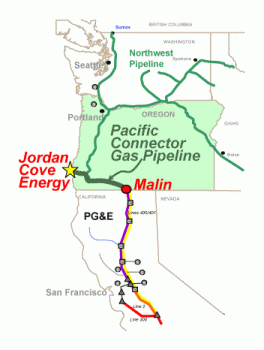Several LNG export terminal projects are planned to allow companies to profit from new markets, increasing the potential profit since prices can easily double, triple, or even reach four times U.S natural gas prices, depending on the market.
Emerging markets such as India and China need energy in order to sustain growth. Japan has been importing LNG for more than four decades and sometimes pays as high as four times the producing country's price. European countries import substantial amounts of LNG as well.

Source: B.C's LNG Strategy
An overlooked project on the Pacific Coast
Jordan Cove Energy Project L.P. is a project planned to provide natural gas to supply the Pacific Northwest's by building a liquefaction facility that will be able to import and export LNG. The terminal would be located in the Oregon International Port of Coos Bay in Coos County, Oregon, a great location for exports to Asia-Pacific markets.

Source: Energy Fundamentals Group
Furthermore, the terminal would be able to receive natural gas via the Pacific Connector Gas Pipeline, a project that will provide a link with existing pipeline systems that converge at Malin, Oregon. Jordan Cove would have a storage capacity of over 11.3 Mmcf of LNG as well as liquefaction capacity of over 6.6 million tons annually and a send-out capacity of 1 Mcf/d with a peak of 1.2 Mcf/d.
The Jordan Cove project is being developed and will be operated by Veresen (TSX: VSN), a Calgary-based owner and operator of several North American energy infrastructure projects such as Alliance Pipeline, a system that connects western Canada's natural gas reserves to large energy markets in the midwestern U.S. and Alberta Ethane Gathering System, the only pipeline that transports ethane to Alberta's petrochemical facilities located at Joffre and Fort Saskatchewan.
Among the infrastructures included with Jordan Cove is South Dunes Power, a facility that will provide a local source of power generation with the capability of reinforcing the local electric grid. Over $7.5 billion in aggregate costs are estimated for the completion of the entire project. Revenue from taxes would account for $20 million to Coos County for the first three years and $30 to $40 million each year thereafter.
The liquefaction plant is expected to receive all required approvals by early 2014 while the construction is scheduled to start in late 2014 with about 3.5 years to complete. Thereby, Jordan Cove is projected to be commissioned in the fourth quarter of 2017.
Kitimat LNG, a direct competitor project
To face Jordan Cove LNG, a more publicized project is taking form north of the border, in Kitimat, British Columbia. Kitimat LNG is a project formed by a consortium of premium energy companies. Owned equally at 50% working interest are Apache (APA 0.74%) and Chevron (CVX 0.32%), with its respective subsidiaries in Canada.

Source: Kitimat LNG
The project will include natural gas liquefaction, LNG storage, and marine on-loading facilities as well as a new 8.7-mile link to the Pacific Trail Pipelines, a pipeline system of 287.7 miles in length that will connect Kitimat to Summit Lake's Spectra Energy gas transmission system.
The pipeline will have up to 1 Bcf/d of gas in capacity and will be operated by Pacific Northern Gas, a company providing natural gas in British Columbia since 1968 to more than 39,900 customers. Pacific has agreed in February 2011 to an initial term of seven years beginning in 2015, with renewal provisions. In December 2011, Pacific was acquired by AltaGas (ALA +0.00%), an energy infrastructure business based in Calgary, Alberta, with a focus on natural gas and regulated utilities.
AltaGas activities includes extraction and transmission, gathering and processing, and distribution services of natural gas. It has interests in six of the 10 extraction plants in Canada, including net inlet capacity of 1.6 Bcf/d, as well as owning and operating six transmission pipelines within the Western Canada Sedimentary Basin. Transmission capacity is estimated at approximately 539 Mmcf/d and three NGL pipelines have a combined capacity of 151.6 Bbls/d.
AltaGas owns approximately 4,039 miles of gathering lines that move the commodity from producing wells to more than 70 field gathering and processing facilities with links with downstream transmission network to give access to major natural gas export pipeline systems and markets. Finally, through AltaGas Utilities, it distributes natural gas to nearly 72,000 customers across Alberta.
Finally, Kitimat's export capacity would be 5.5 million tons per year initially, while Kitimat received an export license from the National Energy Board for 10 million tons annually. The feed of natural gas would come from Apache's Horn River and Liard fields properties in British Columbia that hold approximately 19 Tcf of technically recoverable natural gas resources.
My Foolish take
Several LNG projects are under way in the U.S. and Canada. However, one is definitely passing under the radar of investors. As discussed, Jordan Cove LNG represents a great opportunity to play the LNG exports because of its location and its overall expected capacities. Owned by a seasoned infrastructure company, I believe that Veresen has all the tools required to surprise. To add some incentive, it has a dividend that yields about 8.3%. I would assuredly go for the underdog over giants like Chevron and Apache for the intriguing growth potential Jordan Cove will bring.








